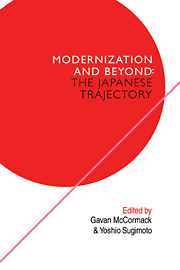Book contents
- Frontmatter
- Contents
- Contributors
- Introduction: modernization and beyond
- I Popular culture: tradition and ‘modernization’
- II Popular movements: alternative visions of ‘modernization’
- III Uneven development and its discontents
- IV Sex, politics and ‘modernity’
- 9 The Japanese women's movement: the counter-values to industrialism
- 10 Male homosexuality as treated by Japanese women writers
- 11 Body politics: abortion law reform
- 12 Division of labour: multinational sex in Asia
- V ‘Modernization’ and ‘modernity’: theoretical perspectives
- Glossary
- Index
9 - The Japanese women's movement: the counter-values to industrialism
Published online by Cambridge University Press: 04 August 2010
- Frontmatter
- Contents
- Contributors
- Introduction: modernization and beyond
- I Popular culture: tradition and ‘modernization’
- II Popular movements: alternative visions of ‘modernization’
- III Uneven development and its discontents
- IV Sex, politics and ‘modernity’
- 9 The Japanese women's movement: the counter-values to industrialism
- 10 Male homosexuality as treated by Japanese women writers
- 11 Body politics: abortion law reform
- 12 Division of labour: multinational sex in Asia
- V ‘Modernization’ and ‘modernity’: theoretical perspectives
- Glossary
- Index
Summary
THE RISE OF THE JAPANESE WOMEN'S MOVEMENT
The 1960s, the decade of Japan's economic ‘miracle’, was also marked by a new wave of the Japanese women's movement, which was deeply rooted in the structural changes of society at the time. It can be said that the Japanese women's movement arose soon after Japan had completed its modernization, as its inevitable side effect.
Although Japanese society had been going through the process of gradual modernization since the Meiji Restoration (1868), this process accelerated rapidly during the 1960s: for example, the urbanization of the population passed the halfway mark, the number of nuclear families increased to 60 percent of all households, and the average number of family members suddenly dropped from five to three (see figure 1). The year 1960 is generally regarded as the first year of ‘rapid economic growth’, when the number of workers employed in industry exceeded that of workers in family businesses (see figure 2). These processes combined to alter the family lifestyle: the urban nuclear family with the sex-role division of working husbands and housewives was established at a mass level.
In terms of family issues, the typical life-cycle pattern of the Japanese people has greatly changed. The Japanese have experienced the so-called ‘biological revolution’ of lower birthrate and longer lifespan (see figure 3). These demographic changes have been universally experienced by most developed industrial societies but what is notable with the Japanese case is that this change was truly a ‘revolution’, because it took place during a very short while.
- Type
- Chapter
- Information
- The Japanese TrajectoryModernization and Beyond, pp. 167 - 185Publisher: Cambridge University PressPrint publication year: 1988
- 9
- Cited by



